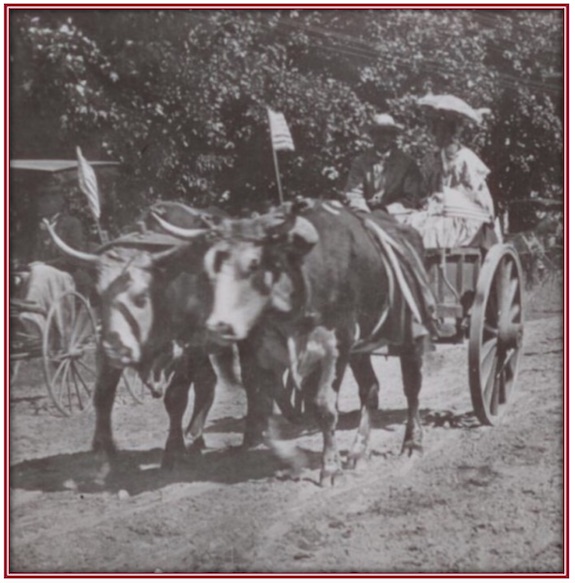Illuminating Orleans: Ox power essential to the early settlers

The Gaines Centennial Parade held in Childs in September 1909 included a team of oxen.
By Catherine Cooper, Orleans County Historian – Vol. 2, No. 6
The struggles encountered by the first settlers in this area are well documented – the long arduous trip from New England or southern New York State, the rough terrain, the hard work required to clear the land.
Their first-person accounts, which are chronicled in the 1871 book Pioneer History of Orleans County by Arad Thomas, describe their struggles and achievements.
But none of those accomplishments would have been possible without oxen. It was ox-power that pulled the laden wagons. It was ox-power that hauled tree stumps out of the ground and logs to the mills.
Oxen, being slow, steady and sure-footed, were more suited to the journey west than horses. They could pull heavier loads than horses, and having more stamina, they could pull steadily for longer periods of time.
Oxen are castrated male cattle, four years old, who have been trained to work. They are referred to in the Bible and were used throughout Europe in medieval times. Oxen are not native to this country, but were brought here by Edward Winslow, a Plymouth Pilgrim who was sent back to England for supplies. He returned in 1624 with three Devon heifers and a Devon bull.
The early travelers to this area generally had one team of oxen, though Andrew Weld of Vermont came in a wagon pulled by three yoke of oxen. The journey generally took a month.
Seymour B. Murdock’s account is one of the more colorful of the Pioneer reminiscences:
“In the transit from Dutchess County, we had a hard time, traveling with an ox team, with a family of twelve persons. We were little more than a month on the way.
From the Genesee River to Clarkson Corners was one dense wilderness.
The roads, if they could properly be called, were completely impassible.
At the crossing of Otter Creek in Gaines, fire had consumed the logs…. which left an almost perpendicular ascent for us to rise. To accomplish this, we took off our oxen and drove them up the old road, and then with teams on the hill, and chains extending from them to the tongues of the wagons below, we drew our wagon up. In doing this, at one time, the draft appeared too much for the team, the oxen fell and were drawn back by the load, and the horn of one of the oxen catching under a root, was torn entirely off.”
The early years were difficult for all, particularly 1816, “The Year with No Summer.”
Adin Manley recalled:
“We had three yoke of oxen and nothing for them to eat, this was the worst of all. We turned them into the woods and cut browse for them, but the poor cattle suffered much.”
Later, when the settlers were more established, oxen played a role in the well-earned “mirthful enjoyment” enjoyed by the younger people. William C. Tanner recounted:
“As cold weather approached, our season for evening parties commenced.
We sometimes went four or five miles to an evening party, on an ox sled, drawn by two yoke of oxen, with as many passengers as could pile on, and as far as appearances would prove, all enjoyed both the ride and the dance first rate.
The first regular ball we attended was held at what is now Millville, in Shelby, July 4, 1819.”
This ball was held in the upper room of a new store, presumably the location of what was later the T.O. Castle store and Post Office, on the corner of Maple Ridge Road and East Shelby Roads.
Oxen were used in Orleans County for quite some time. The Ballou diaries, written in the early 1850s in the Town of Carlton refer to their oxen:
October 21, 1851: Got the oxen shod.
May 24, 1852: One of the oxen is sick.
October 12, 1852: Hosea traded the oxen off today for a horse.
The Agriculture Society of Ridgeway and Shelby’s Fourth Annual Competition held in Medina in September 1861, included a category for Working Oxen “Particular reference will be made to the matching and docility of the animals.”
The Orleans County Agricultural Society Fair held in Albion in June 1871, also included a category for Working Oxen, one for the Best Pair of Working Oxen and one for the Best String of Ten Yoke of Oxen.
Once their laboring days were past, oxen were suitable for providing beef at the age of eight. Ox tongue, oxtail and ox tripe could also be enjoyed while roasted ox heart was an old English classic dish. Ox or cow foot soup was yet another thrifty use of the humble ox. Ox hides were used to make leather.
Despite their stellar qualities, oxen were superseded by horses, as Arad Thomas observed:
“A little progress, and pride and ambition substituted horses and lumber wagons as the common vehicles of travel, in place of the oxen and sleds.”





























































